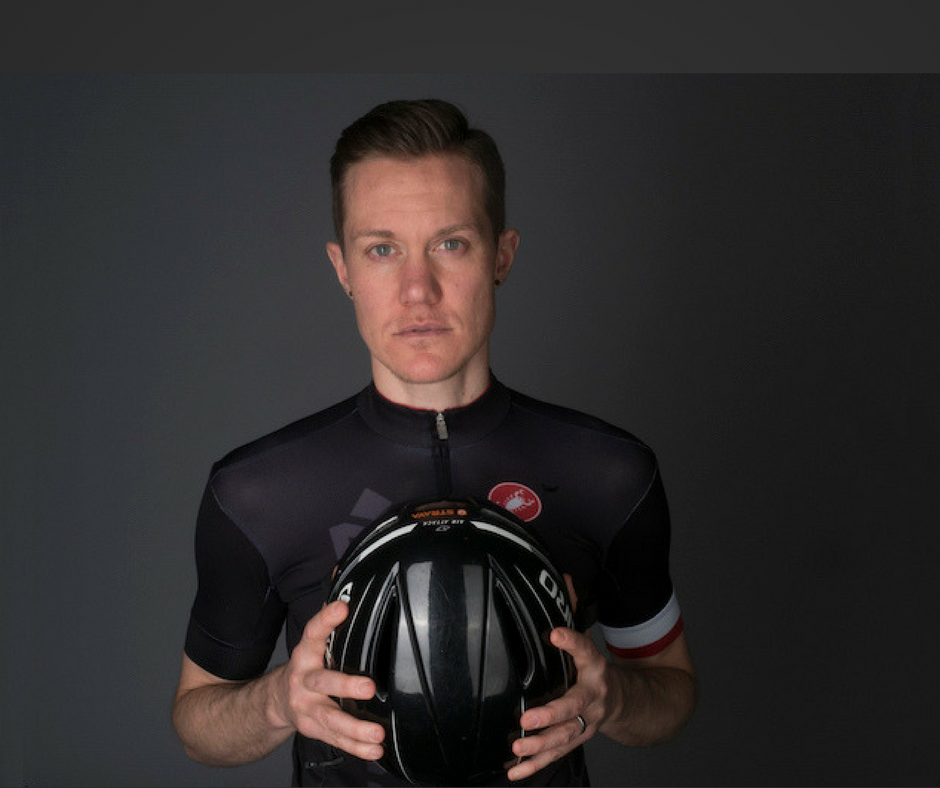March 31, 2018
A Sport In Transition – Triathlon and the Transgender Athlete

When triathlon has its first transgender pro, will we be willing to transition?
by Sara Gross with special thanks to Chris Mosier
Note from the author: On Thursday I got an email from Chris Mosier – March 31st is Transgender Day of Visibility and would I be willing to revisit the podcast we recorded together in 2015? Of course I would! I also revisited and updated an article I wrote for witsup.com, then-titled In Transition. It is strange to re-read my own writing from 2.5 years ago, and while I think I could do better, Ego will have to stay at the door. I hope you enjoy this republished podcast and article (with a few updates!). Comments are always welcome.
Sport does so many great things for community building, making friends, learning self confidence, self discipline, goal setting, and more. People who want to compete should not be denied participation. -Chris Mosier
Whistler, Canada 2006: Downhill mountain biker Michelle Dumaresq won her third Canadian title. At the awards ceremony, second place finisher Danika Schroeter removed her jersey and replaced it with a white T-shirt reading “100% Pure Woman.” During the five years prior, Dumaresq had her cycling license revoked and renewed twice and a petition circulated asking for her disqualification. The reason? Dumaresq was assigned male at birth and had undergone gender confirmation surgery a decade earlier. Despite being considered both medically and legally female (her birth certificate now reads female), and having been granted a 2006 license to race as a woman by both the Canadian Cycling Association (CCA) and the Union Cyclist Internationale (UCI), fellow competitors continued to protest Dumaresq’s presence at races throughout her career.
Consider this: What will happen when triathlon has its first transgender professional?
Dumaresq was very open with her competitors about her past. Many had become close friends and training partners. Most were extremely open and accepting of who she is – until she started to beat them.

Photo: Zhen Heinemann
Categories of Competition
Obstacles for transgender athletes and questions of equity are legion. Cultural norms around the categories “male” and “female” run deep in our personal and collective identities. Consider how quickly some people become uncomfortable when a person walks by who is not immediately identifiable as male or female.
In the sporting context, unlike other realms of life, we compete as ‘men’ and ‘women’ as a means to maintain equity for women athletes. But the definition of what makes a man a man and a woman a woman is not as black and white as we assume.
Let’s unpack this. ‘Gender’ refers to the set of social and cultural norms we attach to ‘male’ and ‘female.’ These norms differ by geographical location, historical era and influence. They are by no means set in stone. Further, biological sex is not completely binary – there are people in the middle. So when exactly does a person stop being a woman and start being a man?
There is an interesting discussion of these points in an Outside Magazine article about Michelle Dumaresq: “What makes most girls girls is their XX chromosomes. But some women possess XY chromosomes while retaining all the physical characteristics of a woman. Some women possess excessive male hormones, a condition known as congenital adrenal hyperplasia.” Further, one in every 2000 people is born with both male and female physical attributes. While transgender people are not the same as those born with intersex conditions, the above outlines the fact that ‘male’ and ‘female’ are not the tidy medical categories we may assume.
A transgender person is someone who identifies with the opposite gender to that which they have been assigned at birth.
Chris Mosier
Leading this conversation in the triathlon world is Chris Mosier. Chris is a four-time member of the US National Triathlon and Duathlon teams (in his age group) and is perhaps best known for starring in this Nike ad from 2016:
https://www.youtube.com/watch?v=_gq8PO9XK2Y
Chris’s views on athletic performance are refreshingly ungendered:
“Great athletes come in all shapes and sizes. And genders. There are athletes assigned female at birth who can definitely hold their own with men. I do think transgender men can be successful in the sport. It will just take the right person to make it to the pro level.”
As triathletes, we should not find this difficult to comprehend. In Ironman races, some of the best runners off the bike are women. In 2015, Kate Bevilaqua became the first woman to win an Ultra Distance triathlon outright. Chris assumed that when he transitioned he would go from competitive woman to middle-of-the-pack man, but the opposite has proven true:
“I’ve gotten more and more competitive in the male age group, working toward the elite level.” Chris says in an Advocate article, “My hope is that athletes who are questioning their gender identity can see me and hear my story and know they don’t have to give up their identity as an athlete to live authentically.”
Chris also feels that the argument that female trans athletes have physical advantages over their competitors is moot: “There are women out there beating men in races,” he said in a Vice Sports article. “There are tall and short men and we don’t discriminate against tall or short athletes. Michael Phelps had long arms, but he didn’t get disqualified for having a competitive advantage. That’s just how he was built. There’s so much variation within genders anyway, a lot of the transphobia is built around that.”
Trans Athletes in History
Transgender issues in sport go back to the 1932 Los Angeles Olympics where Polish sprinter Stella Walsh won a gold medal in the 100 meters. Four years later, she took silver. In 1980, Walsh was shot and killed in Ohio in a robbery. An autopsy revealed that Walsh had male genitalia (2). In the 1940s, Czech runner Zdenka Koubkova competed as a woman but transitioned to a man after retirement. High jumper Dora Ratjen reportedly had intersex genitalia but lived his life as a man with the exception of a three year period in which he was forced by the Nazis to pose as a woman in order to compete in the Olympic Games.

Photo: Zhen Heinemann
According to an article in Outside Magazine; “ In 1966, a chromosomal scan called the Barr body test removed some of the [gender questions]. After a 1968 test determined that Austria’s Erika Schineggar, the women’s world downhill-ski champion, was chromosomally male, she underwent months of surgeries and returned to competition –as Erik.” The Barr body test was discontinued in 1992 because, as discussed above, chromosomes are not the only factor distinguishing the sexes.
Before Caitlyn Jenner, the most famous transgender athlete was physician and tennis player Renée Richards, néé Richard Raskind. In 1977, the New York State Supreme Court ruled that Richards could compete as a woman in the U.S. Open (3). Fears of an unfair advantage for Richards were not met however, as she was knocked out in the first round.
According to a Washington Post opinion piece, “fears of trans women dominating women’s sports have never been realized. Golfer Mianne Bagger may have won Australian national amateur titles, but once she began to play against the pros in the Ladies European Tour, she was quickly relegated to also-ran status. Similarly, while MMA fighter Fallon Fox’s 5-1 professional fight record may seem gaudy, she toils in MMA’s minor leagues and, as so often happens when fighters are elevated, she would be promptly dispatched if she competed in the top-tier Ultimate Fighting Championship.”
A Way Forward
So if transgender men can hold their own in competition against cisgender men (cisgender refers to a person whose gender identity corresponds with the sex assigned at birth), and trans women have yet to dominate the dojo, then what’s stopping governing bodies, event organizers and sponsors from being more supportive? For Fallon Fox, the solution is education: “All of us, especially LGTB youth who are struggling to find their way in a world that often excludes them, deserve the respect of inclusion, on every level.”
Triathlon has a unique opportunity to provide an environment where trans men and women can feel empowered and develop increased confidence as athletes with the associated spillover into life in general. Chris’s experiences with the triathlon community have been largely positive and have helped fuel his work as an advocate:
“In general, I’ve found the triathlon community to be extremely welcoming since transition. My teammates were great when I came out. For most, I was the first transgender person they had met or talked with. There was a small amount of educating that happened, mostly around pronouns in the beginning, but for the most part my teammates educated themselves. In a short time, I simply became one of our guys. I never felt like “the transgender athlete” on our team or in the New York City triathlon community. I appreciated that their acceptance came so quickly and without issue; it has allowed me to be a vocal advocate for inclusion in athletics without fear of being out impacting my place on my team.”

Photo: Zhen Heinemann
Chris goes on to say:
“Athletes at the recreational and age group level should be able to compete with the gender with which they identify, period. Sport does so many great things for community building, making friends, and learning self confidence, self discipline, goal setting, and more. People who want to compete should not be denied participation.”
The experiences of transgender athletes like Chris have the power to transform our understanding of who we are as athletes and also, who we are as people. Maybe the seemingly clear cut boundaries between “man” and “woman” aren’t what they seem? And maybe that very reality can help open our minds to new heights of sporting performance for women.
What’s clear is that the triathlon community should make a conscious effort to welcome and remove barriers for the trans athletes among us. As Chris says:
“Being transgender doesn’t mean all of our sports dreams go away. However, transgender people are underemployed and can still lose their jobs for being trans. It is difficult to find sponsors as an out transgender athlete, and therefore difficult to dedicate the training time to making it to that level. There are still challenges for transgender people in other areas which while not in sport, directly impact one’s ability to compete.”
Shockingly, 41% of transgender people attempt suicide, compared to 4.6% of the overall population.
When a trans person goes through the process of outwardly signifying their internal gender identity, we call this process “transition.” The rest of us have an opportunity to transition as well, to welcome trans athletes with open arms allowing our assumptions about what it means to be “man” and “woman” to be challenged and transformed.


 Outspoken Women in Triathlon Summit Returns Bigger than Ever
Outspoken Women in Triathlon Summit Returns Bigger than Ever  Driving the Lamborghini: Productivity and the Power of Paper
Driving the Lamborghini: Productivity and the Power of Paper  5 take aways from the Compete Sports Diversity Summit
5 take aways from the Compete Sports Diversity Summit  Simple Tips to Hone Your Bike Handling Skills
Simple Tips to Hone Your Bike Handling Skills 


